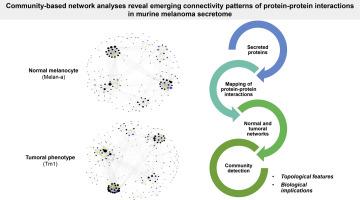Journal of Proteomics ( IF 3.3 ) Pub Date : 2020-12-01 , DOI: 10.1016/j.jprot.2020.104063 Rodrigo Francisquini 1 , Rafael Berton 2 , Sandro Gomes Soares 3 , Dayelle S Pessotti 2 , Maurício F Camacho 2 , Débora Andrade-Silva 4 , Uilla Barcick 2 , Solange M T Serrano 4 , Roger Chammas 5 , Mariá C V Nascimento 1 , André Zelanis 2

|
Protein-protein interaction networks (PPINs) are static representations of protein connections in which topological features such as subgraphs (communities) may contain proteins functionally related, revealing an additional layer of interactome complexity. We created two PPINs from the secretomes of a paired set of murine melanocytes (a normal melanocyte and its transformed phenotype). Community structures, identified by a graph clustering algorithm, resulted in the identification of subgraphs in both networks. Interestingly, the underlying structure of such communities revealed shared and exclusive proteins (core and exclusive nodes, respectively), in addition to proteins that changed their location within each community (rewired nodes). Functional enrichment analysis of core nodes revealed conserved biological functions in both networks whereas exclusive and rewired nodes in the tumoral phenotype network were enriched in cancer-related processes, including TGFβ signaling. We found a remarkable shift in the tumoral interactome, resulting in an emerging pattern which was driven by the presence of exclusive nodes and may represent functional network motifs. Our findings suggest that the rearrangement in the tumoral interactome may be correlated with the malignant transformation of melanocytes associated with substrate adhesion impediment. The interactions found in core and new/rewired nodes might potentially be targeted for therapeutic intervention in melanoma treatment.
Significance
Malignant transformation is a result of synergistic action of multiple molecular factors in which genetic alterations as well as protein expression play paramount roles. During oncogenesis, cellular crosstalk through the secretion of soluble mediators modulates the phenotype of transformed cells which ultimately enables them to successfully disrupt important signaling pathways, including those related to cell growth and proliferation. Therefore, in this work we profiled the secretomes of a paired set of normal and transformed phenotypes of a murine melanocyte. After assembling the two interactomes, clusters of functionally related proteins (network communities) were observed as well as emerging patterns of network rewiring which may represent an interactome signature of transformed cells. In summary, the significance of this study relies on the understanding of the repertoire of ‘normal’ and ‘tumoral’ secretomes and, more importantly, the set of interacting proteins (the interactome) in both of these conditions, which may reveal key components that might be potentially targeted for therapeutic intervention.
中文翻译:

基于社区的网络分析揭示了鼠黑素瘤分泌蛋白中蛋白质相互作用的新兴连通性模式
蛋白质-蛋白质相互作用网络(PPIN)是蛋白质连接的静态表示,其中拓扑特征(如子图(社区))可能包含功能相关的蛋白质,从而揭示了相互作用组复杂性的另一层。我们从成对的鼠黑素细胞(正常黑素细胞及其转化表型)的分泌组中创建了两个PPIN。通过图聚类算法识别的社区结构导致两个网络中子图的识别。有趣的是,这些蛋白质的基本结构揭示了共享的蛋白质和排他的蛋白质(分别是核心节点和排他的节点),以及改变了它们在每个群落中的位置的蛋白质(重新连接的节点)。核心节点的功能富集分析揭示了这两个网络中保守的生物学功能,而肿瘤表型网络中的排他性节点和重新连接的节点在包括TGFβ信号在内的癌症相关过程中富集了。我们发现肿瘤相互作用组发生了显着变化,导致出现了由排他性淋巴结驱动的模式,并可能代表功能性网络基序。我们的发现表明,肿瘤相互作用组的重排可能与与基质粘附障碍相关的黑素细胞的恶性转化有关。在核心和新/重新连接的节点中发现的相互作用可能潜在地成为黑色素瘤治疗的治疗干预目标。包括TGFβ信号传导。我们发现肿瘤相互作用组发生了显着变化,导致出现了由排他性淋巴结驱动的模式,并可能代表功能性网络基序。我们的发现表明,肿瘤相互作用组的重排可能与与基质粘附障碍相关的黑素细胞的恶性转化有关。在核心和新/重新连接的节点中发现的相互作用可能潜在地成为黑色素瘤治疗的治疗干预目标。包括TGFβ信号传导。我们发现肿瘤相互作用组发生了显着变化,导致出现了由排他性淋巴结驱动的模式,并可能代表功能性网络基序。我们的发现表明,肿瘤相互作用组的重排可能与与基质粘附障碍相关的黑素细胞的恶性转化有关。在核心和新/重新连接的节点中发现的相互作用可能潜在地成为黑色素瘤治疗的治疗干预目标。我们的发现表明,肿瘤相互作用组的重排可能与与基质粘附障碍相关的黑素细胞的恶性转化有关。在核心和新/重新连接的节点中发现的相互作用可能潜在地成为黑色素瘤治疗的治疗干预目标。我们的发现表明,肿瘤相互作用组的重排可能与与基质粘附障碍相关的黑素细胞的恶性转化有关。在核心和新/重新连接的节点中发现的相互作用可能潜在地成为黑色素瘤治疗的治疗干预目标。
意义
恶性转化是多种分子因素协同作用的结果,其中遗传改变和蛋白质表达起着至关重要的作用。在致癌过程中,通过可溶性介体分泌的细胞串扰可调节转化细胞的表型,最终使它们能够成功破坏重要的信号通路,包括与细胞生长和增殖有关的信号通路。因此,在这项工作中,我们分析了鼠黑素细胞的一对正常和转化表型的成对分泌物。组装两个相互作用基因组后,观察到功能相关蛋白(网络社区)的簇以及网络重新布线的新兴模式,这可能代表转化细胞的相互作用基因组特征。综上所述,



























 京公网安备 11010802027423号
京公网安备 11010802027423号